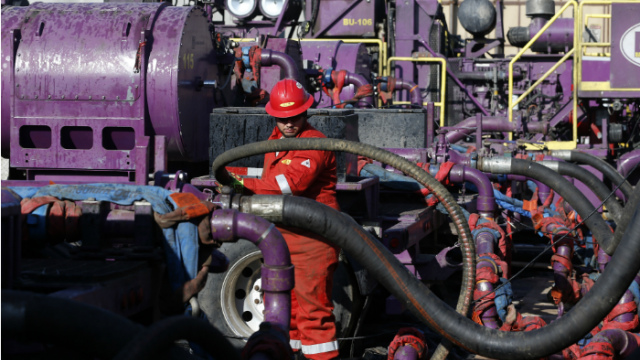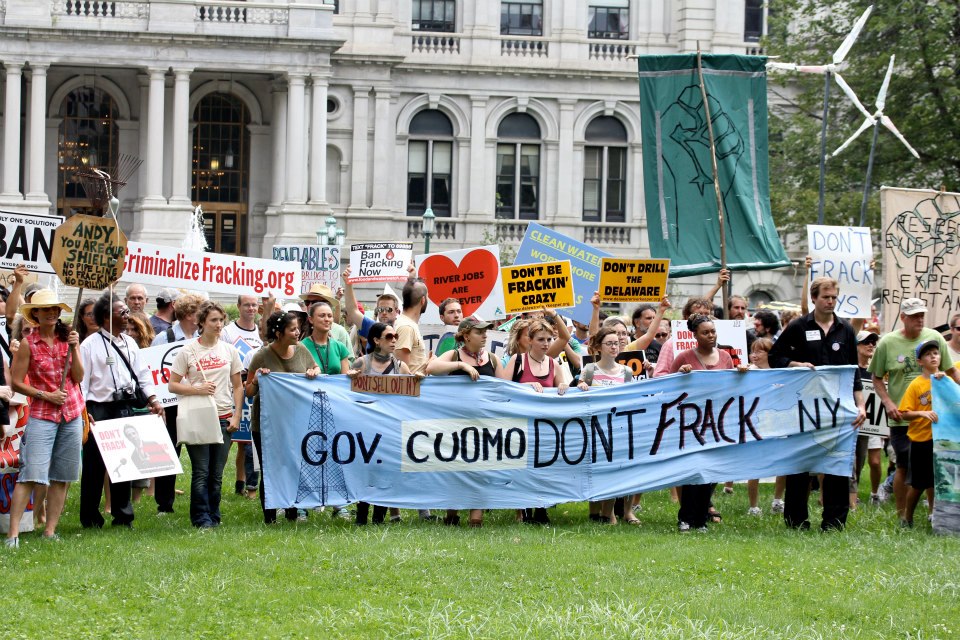
Hydraulic fracking. (AP Photo/Brennan Linsley)
A federal water study commissioned by the Cuomo administration as it weighed a key decision on fracking was edited and delayed by state officials before it was published, a Capital review has found.
The study, originally commissioned by the state in 2011, when the administration was reportedly considering approving fracking on a limited basis, was going to result in a number of politically inconvenient conclusions for Governor Andrew Cuomo, according to an early draft of the report by the U.S. Geological Survey obtained by Capital through a Freedom of Information Act request.
A comparison of the original draft of the study on naturally occurring methane in water wells across the gas-rich Southern Tier with the final version of the report, which came out after extensive communications between the federal agency and Cuomo administration officials, reveals that some of the authors' original descriptions of environmental and health risks associated with fracking were played down or removed.
The final version of the report also excised a reference to risks associated with gas pipelines and underground storage—a reference which could have complicated the Cuomo administration's potential support for a number of other controversial energy projects, including a proposed gas storage facility in the Finger Lakes region that local wine makers say could destroy their burgeoning industry.
Email communications over a period of several months between Cuomo administration officials and federal researchers were obtained by Capital, in heavily redacted form, through a Freedom of Information Act request. The messages reveal an active role by Cuomo's Department of Environmental Conservation in shaping the text, and determining the timing of the report's release.
The emails also show that the department then tracked people who read the study online, grouping them by institutions with which they were affiliated.
In the unredacted part of the emails, a D.E.C. official refers to "alternate text" that he sent. At various points, a U.S. Geological Survey (USGS) spokeswoman thanks a state official for her edits, and reminds the study's author that they are employed by a “science organization” which is not in the business of advocating particular positions. A later communication suggests delays from the administration side, when the USGS spokeswoman refers to a need to publish the report "in a timely fashion.”
The USGS is a federal agency whose scientific studies are reputed to be the gold standard of independent governmental research, and not subject to political pressure.
While there is no evidence to suggest that any numerical findings in the fracking study were changed after the unusually extensive feedback from administration officials, the changes to the explanation of those findings in the report are plain to see.
(Because of the censoring of the emails before they were released to Capital, it is not possible to see exactly how completely the authors of the federal study incorporated the feedback they got from state officials.)
In the early study draft, author Paul Heisig noted that gas “drilling, extraction, transport via pipelines, and underground storage” could inadvertently introduce methane into drinking water supplies.
But the version published after the copy was reviewed and edited by staff members from the state D.E.C. and New York State Energy Research and Development Authority omits the reference to pipelines and underground storage. The later, administration-vetted version also includes a line that wasn't in the earlier draft, saying that methane pollution risks in fracking are mitigated by well designed gas wells: “This risk can be reduced if the casing and cementing of wells is properly designed and constructed.”
These edits happen to correlate closely with some potential environmental and energy minefields for the governor. The Cuomo administration, for example, is currently weighing whether or not to permit gas storage in underground salt caverns near the Finger Lakes. Opponents of the project have raised the prospect of methane pollution as a reason to deny the project.
In addition, a number of gas pipeline projects have been proposed for the state. Cuomo has pushed coal-burning power plants to switch to gas, which may require more pipelines.
But the administration’s involvement in shaping the report seems designed, above all, to mitigate any political complication it might have caused the governor as he formulated his plan for fracking.
Cuomo had been inconvenienced by the fracking issue from early on in his administration, and it has continued to come up as he runs for re-election—first during the Democratic primary, when his opponent Zephyr Teachout assailed him for not banning the practice, and now as his Republican challenger Rob Astorino calls for the lifting of the state’s ostensibly temporary moratorium.
But Cuomo has muted any truly serious backlash from either side in the fracking debate by effectively taking and maintaining a non-position: He’s holding off as he waits for unspecified studies, with unspecified timelines, on the potential health impacts. In the meantime, a moratorium remains in place that could theoretically be lifted at anytime. Cuomo has indicated only that nothing will change before Election Day.
Cuomo has adopted a similar delay policy on a number of other politically fraught energy projects, avoiding easily discernible positions on the proposed propane storage project in the Finger Lakes and on a crude-oil rail hub in Albany.
But Cuomo’s dodge on fracking has been his most conspicuous one, and the most painstakingly engineered.
At the time NYSERDA ordered the methane study in late 2011, the Cuomo administration appeared to be inching toward what it saw as politically acceptable compromise that would have allowed fracking on a limited scale in a few of the Southern Tier counties. The federal study was a step on the way to implementing that plan—it established the baseline level of methane in the groundwater before fracking, providing a basis for before-after comparison, and a preemptive defense against later claims of pollution from fracking opponents.
The state’s contract with the federal agency that conducted the study, which the state claimed was privileged information but which was obtained by Capital from the USGS via a separate FOIA request, explicitly says that “the objective of the proposed study is to define a pre-shale-gas-development baseline.”
During the time period in which the study was underway, the administration floated the plan in the New York Times. After a poor reception, the trial ballon was hauled down, and the administration shifted from fracking preparation to its current mode, which is, officially, ongoing study.
Today, the administration maintains that its interactions with the federal entities that conducted that original methane study were standard, and in the interests of science.
Asked about the state’s exchanges with USGS and the effect they had on the final report, a spokeswoman provided the following statement: “While the report was drafted by USGS, it simply underwent a technical review by NYSERDA staff and other experts, including experts from other state agencies like the Department of Environmental Conservation. Edits suggested through NYSERDA’s technical review process were discussed with USGS, which is common and standard practice between parties with any scientific study. This study clearly underscores the State’s resolve and commitment to having the most current and reliable scientific data to draw upon before decisions are made that may affect New Yorkers. In addition, this study complements the mission and objectives of NYSERDA’s Environmental Monitoring and Evaluation program, which produces nearly 50 reports annually.”
After one flurry of emails from state officials among the dozens that were exchanged, United State Geological Survey spokeswoman Diane Noserale warned a state official that the methane survey needed to be released soon.
“Please understand that it is our duty to announce publicly the results of our scientific studies in a timely and efficient fashion,” she wrote.
At another point, Paul Heisig, the author of the study, wrote to Gregory Lampmann, senior project manager at NYSERDA, saying, "Here's the alternate text you requested. See if this works.”
Attempts to influence scientific studies, or edit out sections unfavorable to the Cuomo administration's policy goals, have become more common over the last four years, according to multiple sources familiar with the operations of the Cuomo administration's D.E.C.
While some back-and-forth on studies is not unusual and is often written in to the contract, according to the sources familiar with the process, the communication related to the contents and timing of the report that was to result from the particular methane study was particularly intense.
Fracking can produce methane pollution and the study by the U.S. Geological Survey is the type of benchmark that other states such as Pennsylvania have sorely needed as regulators grapple with the environmental effects of energy production in those states. The well surveys were conducted only in the gas-rich counties that would be the epicenter of the state's fracking industry if it were ever to become legal. The study, which collected samples from 66 water wells, found naturally occurring methane levels in 15 percent of the wells were high enough to require mitigation.
In response to the Freedom of Information requests for the state’s input on the study, NYSERDA would only release a budget and a few heavily redacted emails. The USGS released dozens of emails, but they were also heavily redacted. USGS also released the full contract signed by state officials, which the state had refused to provide.
“The objective of the proposed study is to define a pre-shale-gas-development baseline for methane occurrence in domestic wells across a subsection of the Marcellus gas-play area,” the contract stated.
Though heavily redacted, the emails show a number of New York officials were involved in the study’s drafting, including Eugene Leff, a Department of Environmental Conservation deputy commissioner. Leff is a longtime Cuomo loyalist who worked for the governor back when he was attorney general, and whose installment at the D.E.C. was a priority for Cuomo after his election in 2010.
The $262,000 study was jointly funded by the USGS and the state, with New York's contribution about $160,000. The study area included Chemung, Tioga, Broome, Chenango, Delaware and Otsego counties.
Methane is naturally occurring, but fracking can force methane to migrate underground to drinking water wells where it might not otherwise be present. In Pennsylvania, where fracking is a multibillion industry, there was no widespread baseline test of water well quality before drilling began. That has posed a significant challenge for state regulators and energy companies trying to determine if methane pollution was caused by industry.
Anti-fracking activists carry jugs of methane-laden water with them to all of the state's major protests. The famous-among-environmentalists jug of brown “Dimock-water” comes from a Pennsylvania town where a fracking operation polluted nearby wells. Wells that produce significant amounts of methane can ignite right at the faucet, though sometimes this is naturally occurring and has nothing to do with fracking.
After one flurry of emails from state officials, USGS spokeswoman Noserale cut and pasted federal policy governing studies for use by the report’s author, as he corresponded with New York officials, to “clarify our role as a science organization.” A section of text highlighted in that email stated that “information products do not advocate or appear to advocate a particular public policy.”
By the administration’s reckoning, the study was read about by 18,000 people in its first week online, according to the emails obtained by Capital. NYSERDA officials grouped those readers into a few categories including Syracuse and Penn State universities, the U.S. Department of Energy, Chesapeake Energy, state government addresses and a “known state landowner/lease group cooperative,” which is likely the Joint Landowners Coalition.
In one email dated December 16, 2013 (the day before the study was released), Noserale, the USGS spokeswoman, thanked the NYSERDA spokeswoman for her edits. In another, she thanked NYSERDA officials for their “rigorous review.”
“Although I don't expect that you will get questions from the media, please advise if you do!” Noserale wrote. “I think that your funding of this work and the rigorous review shows that the state is serious about this issue.”
3 WAYS TO SHOW YOUR SUPPORT
- Log in to post comments














